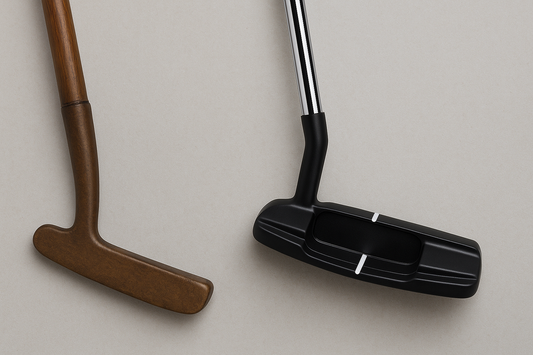For most of golf's history, the putter was the club that refused to evolve. Steel blade. Shaft. Done. Everything else was feel.
That era is over.
Walk into any major retailer today and you'll see putters that would've seemed like science fiction two decades ago. Aerospace alloys. CFD modeling. Weight distribution concepts lifted straight from Formula 1. The flatstick has turned into a testbed for materials engineering and biomechanics, and I'm not just talking about a fresh coat of paint.
The Materials Revolution
Steel still exists, but it's no longer king.
Today's manufacturers pull from across the periodic table: aluminum, titanium, tungsten, and carbon fiber. Each material solves a specific problem.
Tungsten's density, for instance, makes it perfect for perimeter weighting. Load tungsten into the heel and toe, and you jack up the moment of inertia. What does that mean in English? Miss the sweet spot — toe it, heel it, doesn't matter — and the ball still tracks reasonably close to your intended line. Ball speed stays consistent. Direction doesn't spray.
And trust me, this matters. I've yet to meet a golfer who consistently finds the center of the face on a six-footer with the match on the line.
Multi-material construction also gives designers unprecedented control over sound and feel. Soft aluminum face with a stainless steel body? That's one feedback profile. Add a polymer insert and you get something completely different. Some putters now incorporate five or six distinct materials, each chosen for a specific acoustic or mechanical property. We're talking aerospace-level precision here.
Face Technology and Roll Characteristics
Here's where it gets interesting.
High-speed video analysis exposed something most golfers never knew: the ball doesn't actually roll right after you hit it. It skids. For the first several feet, in fact, before finally transitioning into true roll. That skid phase is both inconsistent and destructive — it introduces directional variance you can't compensate for.
Modern face designs attack this directly. Grooves bite into the ball's urethane cover. Some groove patterns angle upward to help lift the ball out of its slight depression in the green. Insert materials are formulated with specific durometer ratings and surface treatments to optimize the friction coefficient at impact. The entire goal: kill the skid phase and get the ball rolling forward as quickly as possible.
You'll see different approaches. Variable-depth grooves — deeper in the middle, shallower at the edges. Progressive face textures. Differential hardness zones. But they're all chasing the same thing: predictable roll regardless of impact location or stroke speed.
Alignment and Visualization Aids
Aiming a putter should be easy. It's not.
Yes, alignment lines have been around forever. However, what you're seeing now extends far beyond a single white stripe. Current designs incorporate findings from optical research and perceptual psychology. Contrasting color blocks. 3D geometric shapes. Multi-point alignment systems. Some putters use raised rails that cast shadows, creating an almost foolproof reference for square contact. Others use patterns that essentially frame the ball and create a visual highway to your target line.
This stuff works. Studies show improved alignment at address can reduce directional error by 2-3 degrees. From twelve feet, that's the difference between draining it and missing. For mid-to-high handicappers who struggle with aim? The improvement can be dramatic.
Adjustability and Customization
No two golfers putt the same way. The industry finally gets this.
Movable weights. Adjustable lie angles. Loft sleeves you can swap without visiting a clubfitter. Modern putters can be fine-tuned to suit your stroke and the conditions you're playing in. Change the weight distribution to alter swing weight and balance point. Tweak the hosel to modify lie and loft in thirty seconds. High-end models even offer swappable face inserts, allowing you to adjust the feel and roll characteristics based on green speed or personal preference.
Ten years ago, this level of customization meant scheduling an appointment and waiting a week. Now you do it in your living room.
The Data-Driven Approach
All of this innovation is built on data — mountains of it.
Launch monitors and putting analysis systems now track a wide range of metrics: face angle, path, tempo, impact location, launch angle, skid distance, and roll quality. Hundreds of variables per stroke. Manufacturers use this information to guide design decisions and identify exactly what separates made putts from missed ones.
The old saying holds: you can't manage what you don't measure. Golf finally figured that out.
The Bottom Line
Purists hate this. Too much tech. Too complicated. Not real golf.
But the numbers don't care about nostalgia. Modern putters reduce three-putt rates. Alignment systems build confidence over short putts. Better roll characteristics improve distance control. Forgiveness turns mediocre strokes into acceptable results.
This isn't about replacing skill with technology. It's about removing friction between what you intend to do and what actually happens. Hand someone a tool that complements their natural motion, rather than fighting it, and they'll perform better. That's not controversial — it's obvious.
Materials science keeps progressing. Design software continues to become more sophisticated every year. Five years from now, today's cutting-edge putters will look quaint. Whether you think that's good or bad is up to you, but it's happening either way.
The flatstick stopped being flat a long time ago.





